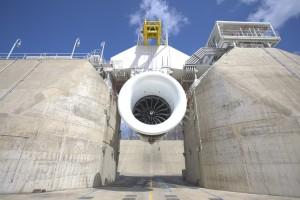 A year ago, GE Aviation began incorporating 3D printed components into their jet engines for the first time ever, retrofitting hundreds of their GE90 engines with 3D printed sensor housings. At that time, the GE90 was the largest jet engine in the world, but today it must relinquish that title with the introduction of the GE9X, a gigantic beast of an engine developed for the new Boeing 777X airplane. Recently, GE fired the engine up and began testing it out in the woods near Peebles, Ohio, the company’s dedicated testing site.
A year ago, GE Aviation began incorporating 3D printed components into their jet engines for the first time ever, retrofitting hundreds of their GE90 engines with 3D printed sensor housings. At that time, the GE90 was the largest jet engine in the world, but today it must relinquish that title with the introduction of the GE9X, a gigantic beast of an engine developed for the new Boeing 777X airplane. Recently, GE fired the engine up and began testing it out in the woods near Peebles, Ohio, the company’s dedicated testing site.
The GE9X sports a front fan with a world record 11-foot (3.35-meter) diameter, but the engine isn’t just bigger than its predecessors. It’s also the most fuel-efficient engine GE has ever produced, and can generate 100,000 pounds of thrust – not the world’s most powerful, but close. (Comparatively, a space shuttle engine produces 375,000 pounds of thrust.) Oh, and it has several 3D printed parts, namely fuel nozzles. Thanks to 3D printing, engineers were able to design complex internal shapes that would have been impossible with other manufacturing techniques. Don’t look for too much detail on those components, though.
“These tunnels and caves are a closely guarded secret,” said Rick Kennedy, a spokesman for GE Aviation. “They determine how the fuel moves through the nozzle and sprays inside the combustion chamber.”
The nozzles also greatly reduce the weight of the engine, as well as the noise level – on a per-pounds-of-thrust basis, it’s the quietest engine GE has ever produced. Then there’s the heat-resistance. The engine’s core consists largely of ceramic matrix composites (CMCs), capable of withstanding temperatures of up to 2,400°F.
“The hotter the engine runs, the more efficient it is.” said Kennedy.
 Also contributing to the engine’s fuel efficiency are 16 fourth-generation carbon fiber fan blades, which push air into an 11-stage high-pressure compressor with a 27:1 pressure ratio – the highest pressure ratio of any commercial engine in service. The GE9X has been in development for several years, and GE has already tested many of the components on their own; this was the first time the full engine was tested, however.
Also contributing to the engine’s fuel efficiency are 16 fourth-generation carbon fiber fan blades, which push air into an 11-stage high-pressure compressor with a 27:1 pressure ratio – the highest pressure ratio of any commercial engine in service. The GE9X has been in development for several years, and GE has already tested many of the components on their own; this was the first time the full engine was tested, however.
“Due to the significant amount of new technologies in the GE9X, we planned the testing program differently,” said GE9X program leader Chuck Jackson. “The early testing informed the design and manufacturing and allowed us to freeze the product definition and test the total engine as soon as possible.”
While the GE9X won’t go into commercial service for a few years yet, GE has already received over 700 orders for the engine from several major airlines. A $10 million investment went into the testing program, which will continue for several months until the aerodynamic, thermal and mechanical characteristics of the engine are verified. The second iteration of the engine will begin undergoing testing next year.
GE has made no secret of the fact that they are very serious about 3D printing; they’ve made several huge investments in the technology over the past two years. Based on the early demand for the GE9X engine, it certainly looks as though those investments are going to pay off. You can see a video of the testing of the GE9X below. Discuss your thoughts on the use of this technology in the GE Jet Engine & 3D Printing forum over at 3DPB.com.
https://youtu.be/nurk_4zpx-s
[Source/Images: GE Reports]
Subscribe to Our Email Newsletter
Stay up-to-date on all the latest news from the 3D printing industry and receive information and offers from third party vendors.
Print Services
Upload your 3D Models and get them printed quickly and efficiently.
You May Also Like
3D Printing News Briefs, July 2, 2025: Copper Alloys, Defense Manufacturing, & More
We’re starting off with metals in today’s 3D Printing News Briefs, as Farsoon has unveiled a large-scale AM solution for copper alloys, and Meltio used its wire-laser metal solution to...
3DPOD 260: John Hart on VulcanForms, MIT, Desktop Metal and More
John Hart is a Professor at MIT; he´s also the director of the Laboratory for Manufacturing and Productivity as well as the director of the Center for Advanced Production Technologies....
3D Printing News Briefs, June 28, 2025: Defense Accelerator, Surgical Models, & More
In this weekend’s 3D Printing News Briefs, 3YOURMIND was selected to join an EU Defense Accelerator, and PTC has announced model-based definition (MBD) capabilities within Onshape. Finally, a study out...
EOS in India: AM’s Rising Star
EOS is doubling down on India. With a growing base of aerospace startups, new government policies, and a massive engineering workforce, India is quickly becoming one of the most important...


































